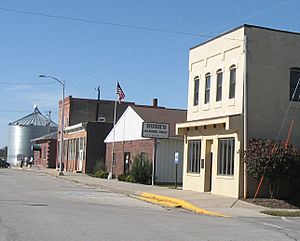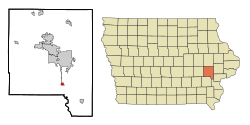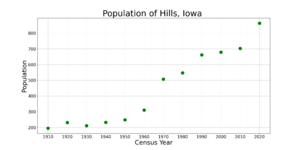Hills, Iowa facts for kids
Quick facts for kids
Hills, Iowa
|
|
|---|---|

Hills, Iowa
|
|
| Motto(s):
Where town and country meet
|
|

Location of Hills, Iowa
|
|
| Country | |
| State | |
| County | Johnson |
| Area | |
| • Total | 0.82 sq mi (2.12 km2) |
| • Land | 0.82 sq mi (2.12 km2) |
| • Water | 0.00 sq mi (0.00 km2) |
| Elevation | 630 ft (192 m) |
| Population
(2020)
|
|
| • Total | 863 |
| • Density | 1,052.44/sq mi (406.51/km2) |
| Time zone | UTC-6 (Central (CST)) |
| • Summer (DST) | UTC-5 (CDT) |
| ZIP code |
52235
|
| Area code(s) | 319 |
| FIPS code | 19-36345 |
| GNIS feature ID | 0457499 |
Hills is a small city in Johnson County, Iowa, United States. It is part of the larger Iowa City, Iowa area. In 2020, about 863 people lived there. Hills is also part of the Iowa City Community School District. Its motto is "Where town and country meet."
Contents
Geography of Hills
Hills is located in the state of Iowa. You can find it at these coordinates: 41.557041 degrees North and -91.534992 degrees West. This helps pinpoint its exact spot on a map.
The city covers a total area of about 2.12 square kilometers (0.82 square miles). All of this area is land. There are no large bodies of water, like lakes or rivers, within the city limits.
Population and People
A "census" is an official count of how many people live in a place. It also gathers information about them. The United States government conducts a census every ten years. This helps us understand how cities like Hills are growing and changing.
How Hills Has Grown
| Historical populations | ||
|---|---|---|
| Year | Pop. | ±% |
| 1910 | 195 | — |
| 1920 | 231 | +18.5% |
| 1930 | 211 | −8.7% |
| 1940 | 232 | +10.0% |
| 1950 | 248 | +6.9% |
| 1960 | 310 | +25.0% |
| 1970 | 507 | +63.5% |
| 1980 | 547 | +7.9% |
| 1990 | 662 | +21.0% |
| 2000 | 679 | +2.6% |
| 2010 | 703 | +3.5% |
| 2020 | 863 | +22.8% |
| Source: and Iowa Data Center Source: |
||
The population of Hills has steadily grown over many years. In 1910, only 195 people lived there. By 2020, the population had increased to 863 people. This shows that more and more people have chosen to make Hills their home over time.
Life in Hills in 2020
According to the 2020 census, 863 people lived in Hills. There were 403 households, which are groups of people living together in one home. Many of these households were families.
Most of the people in Hills were White. There were also residents from other racial backgrounds. A small percentage of the population identified as Hispanic or Latino.
The average age of people in Hills was about 41.6 years old. About 21% of the residents were under 20 years old. This means Hills is home to people of all ages, from young children to older adults.
Life in Hills in 2010
The 2010 census counted 703 people living in Hills. There were 299 households at that time. Like in 2020, most residents were White. There were also people from other racial and ethnic groups.
The average age in 2010 was 45.2 years. About 20% of the residents were under 18 years old. The city has seen a good amount of growth in its population between 2010 and 2020.
See also
 In Spanish: Hills (Iowa) para niños
In Spanish: Hills (Iowa) para niños


